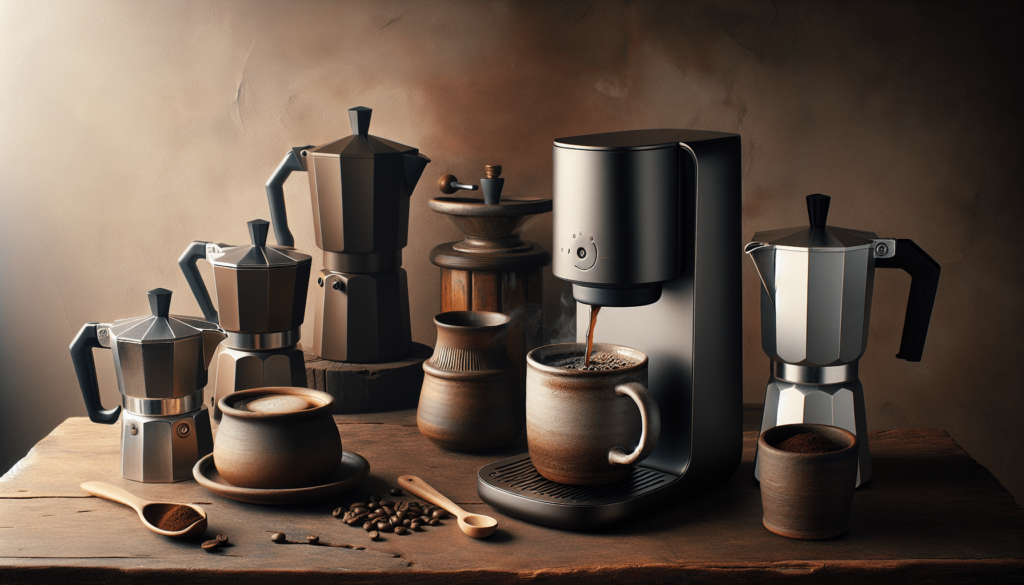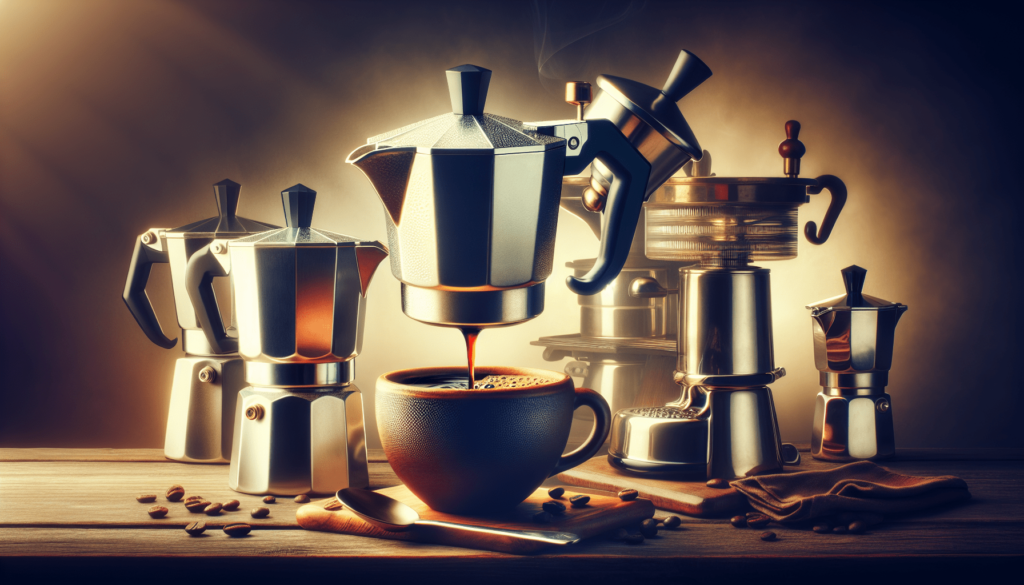How many ways can coffee be made? You might be surprised at the variety of methods available to brew your favorite cup of joe. Coffee has been enjoyed for centuries, evolving into a beverage with countless preparation techniques. Whether you are a coffee aficionado or a casual drinker, understanding the different ways to make coffee can enrich your experience and maybe even elevate your morning routine.

Brewing Methods: An Overview
There are myriad ways to transform coffee beans and water into a delectable drink. These methods can be broken down into several categories: immersion, pour-over, espresso, cold brew, and stovetop. Each technique offers a unique flavor profile, brewing time, and level of complexity.
Immersion Brewing
Immersion brewing methods involve steeping coffee grounds in water for a certain amount of time, allowing for thorough extraction of flavors.
French Press
The French Press is a classic immersion method originating from France. It’s known for its simplicity and robust flavor.
Steps:
- Coarsely grind your coffee beans.
- Add the coffee grounds to the French Press.
- Pour in hot water and stir.
- Place the lid and let it steep for about 4 minutes.
- Press the plunger down and pour your coffee.
Pros:
- Full-bodied flavor
- Simple to use
- No need for paper filters
Cons:
- Can be gritty if not carefully poured
- Requires a coarse grind to avoid over-extraction
AeroPress
The AeroPress is a versatile and portable immersion brewing device. Invented in 2005, it has gained a cult following for its ability to produce both American-style coffee and espresso-like shots.
Steps:
- Place a paper filter in the AeroPress cap.
- Add finely ground coffee to the chamber.
- Pour in hot water and stir.
- Attach the cap and press down the plunger.
Pros:
- Quick brewing time
- Produces a clean cup
- Portable and lightweight
Cons:
- Requires specific AeroPress filters
- Smaller capacity, ideal for single servings
Pour-Over
Pour-over methods involve manually pouring water over coffee grounds, allowing you to control the rate of water flow and extraction.
Chemex
The Chemex brewer is a stylish and scientific method created in the 1940s. It features a glass flask and uses thick paper filters, providing a clean and nuanced cup of coffee.
Steps:
- Place a Chemex-specific filter in the top of the flask.
- Add medium-coarse ground coffee into the filter.
- Slowly pour hot water over the coffee in a circular motion.
- Allow the coffee to drip into the flask.
Pros:
- Elegant and sophisticated design
- Produces a clean and bright cup
- Large capacity options
Cons:
- Requires practice to perfect
- Fragile glass construction
Hario V60
The Hario V60 is another popular pour-over method from Japan, known for its cone-shaped design and spiral ridges to guide water flow.
Steps:
- Place a V60 filter in the cone.
- Add medium-fine ground coffee to the filter.
- Pour hot water in a controlled, spiral motion.
- Allow the coffee to drip through.
Pros:
- Offers great control over the brewing process
- Compact and affordable
Cons:
- Steep learning curve
- Requires a gooseneck kettle for best results
Espresso
Espresso is a staple in many coffee shops and is the base for many popular drinks like lattes and cappuccinos. It involves forcing hot water through finely-ground coffee at high pressure.
Traditional Espresso Machine
Using a traditional espresso machine requires some practice and skill but yields a rich and concentrated espresso shot.
Steps:
- Finely grind your coffee beans.
- Tamp the grounds into the portafilter.
- Attach the portafilter to the machine.
- Start the machine to brew the espresso shot.
Pros:
- Produces high-quality espresso
- Essential for making other coffee drinks
Cons:
- Steep learning curve
- Expensive and large footprint
Nespresso
For those seeking convenience without sacrificing too much quality, Nespresso machines offer a quick and easy way to make espresso using pre-packed capsules.
Steps:
- Insert a Nespresso capsule.
- Press a button to start brewing.
Pros:
- Extremely easy to use
- Minimal cleaning required
Cons:
- Capsules can be expensive
- Less control over the brewing process
Cold Brew
Cold brew is a popular summer choice and is known for its smooth, sweet flavor. Unlike other methods, it uses cold water and a long steeping time.
Cold Brew Maker
A cold brew maker simplifies the process, ensuring you get a consistent brew every time.
Steps:
- Add coarsely ground coffee to the filter.
- Pour cold water over the coffee grounds.
- Steep in the refrigerator for 12-24 hours.
- Remove the filter and enjoy.
Pros:
- Smooth, sweet flavor
- Easy to make in large batches
Cons:
- Long steeping time
- Requires more coffee grounds
Stovetop Brewing
Stovetop brewing methods generally involve heating water and coffee together on a stove, which can produce distinct and strong flavors.
Moka Pot
Originating from Italy, the Moka Pot brews coffee by passing boiling water through coffee grounds under pressure.
Steps:
- Fill the bottom chamber with water.
- Add finely ground coffee to the filter basket.
- Assemble the pot and place it on the stove.
- Wait until you hear a hissing sound, indicating brewing is complete.
Pros:
- Rich, espresso-like coffee
- Affordable and durable
Cons:
- Can be tricky to master
- Prone to over-extraction if left unattended
Factoring In Coffee-to-Water Ratio
Regardless of the brewing method you choose, maintaining a proper coffee-to-water ratio is crucial for a balanced cup. Here’s a handy table to guide you:
| Brewing Method | Coffee-to-Water Ratio |
|---|---|
| French Press | 1:15 |
| AeroPress | 1:7 to 1:16 (preferences vary) |
| Chemex | 1:17 |
| Hario V60 | 1:16 |
| Traditional Espresso | 1:2 |
| Cold Brew | 1:4 for concentrate, 1:8 after dilution |
| Moka Pot | 1:7 |
Grinding the Beans: Why It Matters
The grind size of your coffee beans can significantly impact the flavor and quality of your brew. Different methods require different grind sizes:
- Coarse Grind: Ideal for French Press and Cold Brew.
- Medium-Coarse Grind: Suitable for Chemex.
- Medium-Fine Grind: Best for Hario V60.
- Fine Grind: Necessary for Espresso and AeroPress.
- Very Fine Grind: Essential for Turkish Coffee.
Water Temperature and Quality
Using the right water temperature ensures proper extraction. Generally, a range of 195°F to 205°F is ideal for most methods. Cold brew is the exception, as it uses cold or room temperature water.
Water quality also plays a role. Using filtered water can prevent unwanted minerals and chemicals from affecting the taste of your coffee.

Adding Milk and Sugar
Once you’ve mastered brewing techniques, you might explore how milk and sugar alter your coffee’s flavor. Each addition can interact differently depending on the brewing method.
- Espresso-based drinks: Commonly paired with steamed milk to create lattes and cappuccinos.
- Cold Brew: Often mixed with milk or cream for added sweetness and texture.
- Black Coffee: Many purists prefer it without additives, but a small amount of sugar or cream can enhance the flavor for some.
Specialty Coffee Drinks
Beyond basic brewed coffee, there are countless specialty drinks that incorporate various brewing methods. Here are a few popular ones:
Latte
A latte is made with one-third espresso and two-thirds steamed milk, topped with a small amount of milk foam.
Cappuccino
This drink is similar to a latte but with equal parts espresso, steamed milk, and milk foam.
Americano
An Americano involves diluting an espresso shot with hot water, creating a less intense flavor profile.
Macchiato
A macchiato consists of an espresso shot “stained” with a small amount of steamed milk.
Conclusion
Coffee can be made in a variety of ways, each offering a unique experience and flavor profile. Whether you prefer the full-bodied richness of a French Press, the clean brightness of a Chemex, or the robust intensity of an espresso, understanding these methods can help you find your perfect brew. The journey of exploring different preparation techniques can enhance your appreciation for this beloved beverage. Enjoy your exploration and may every cup bring you closer to coffee nirvana.
